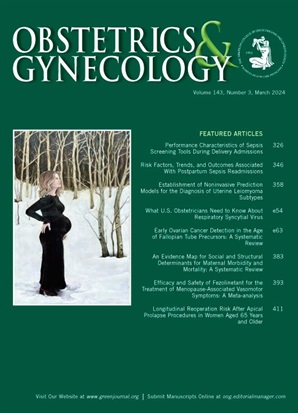A Feasibility Study for Mapping Ovarian Sentinel Lymph Nodes: A Memorial Sloan Kettering Cancer Center Team Ovary Study.
IF 4.7
2区 医学
Q1 OBSTETRICS & GYNECOLOGY
引用次数: 0
Abstract
BACKGROUND To evaluate four methods of injecting indocyanine green (ICG) around the adnexa and identify the optimal technique for ovarian sentinel lymph node (SLN) mapping. METHOD Patients presenting for management of an adnexal mass were prospectively enrolled. Patients with peritoneal carcinomatosis were excluded. Four injection methods were evaluated: 1) intratubal, 2) paraovarian peritoneum, 3) infundibulopelvic (IP) ligament after resection of the adnexal mass, and 4) IP ligament before resection of the adnexal mass. Two mL of ICG was injected, and at least 10 minutes of transit time was allowed. The ipsilateral and contralateral pelvic and para-aortic lymph node beds were evaluated for ICG uptake. Retroperitoneal nodal resection was performed if indicated. EXPERIENCE Forty patients were enrolled, 10 in each group. For method 1, 20.0% of SLNs mapped, all to the ipsilateral para-aortic lymph node bed. For method 2, 10.0% mapped, only to the ipsilateral para-aortic lymph node bed. For method 3, 50.0% mapped to the ipsilateral para-aortic lymph node bed (n=3), contralateral para-aortic lymph node bed (n=1), or ipsilateral pelvic lymph node bed (n=1). For method 4, 70.0% mapped to the ipsilateral para-aortic lymph node bed (n=5) or ipsilateral pelvic lymph node bed (n=2). Surgeons reported methods 1 and 2 as cumbersome, and excessive peritoneal staining made SLN identification difficult. No injection-related complications were reported. CONCLUSION Injection of ICG into the IP ligament before or after adnexal mass resection led to similar rates of SLN mapping and was deemed feasible by surgeons. Only one SLN was identified contralateral to the adnexal mass, and all but three mapped to the para-aortic region. Injection into the IP ligament should be evaluated in patients with likely adnexal malignancy, including SLN resection.绘制卵巢前哨淋巴结的可行性研究:纪念斯隆凯特琳癌症中心小组卵巢研究。
目的:评价附件周围注射吲哚青绿(ICG)的四种方法,确定卵巢前哨淋巴结(SLN)定位的最佳方法。方法前瞻性纳入前来治疗附件肿块的患者。排除腹膜癌患者。对四种注射方式进行了评价:1)输卵管内注射,2)卵巢旁腹膜注射,3)附件肿物切除后的盂底韧带注射,4)附件肿物切除前的IP韧带注射。注射ICG 2 mL,至少10分钟的传递时间。对同侧和对侧盆腔和主动脉旁淋巴结床进行ICG摄取评估。如有指征,行腹膜后淋巴结切除术。实验共纳入40例患者,每组10例。对于方法1,20.0%的sln被映射到同侧主动脉旁淋巴结床。对于方法2,10.0%仅映射到同侧主动脉旁淋巴结床。对于方法3,50.0%映射到同侧主动脉旁淋巴结床(n=3),对侧主动脉旁淋巴结床(n=1)或同侧盆腔淋巴结床(n=1)。对于方法4,70.0%映射到同侧主动脉旁淋巴结床(n=5)或同侧盆腔淋巴结床(n=2)。外科医生报告方法1和方法2很麻烦,过多的腹膜染色使SLN难以识别。无注射相关并发症报道。结论在附件肿块切除术前后,在IP韧带内注射ICG可获得相似的SLN定位率,外科医生认为这是可行的。只有一个SLN在附件肿块的对侧被发现,除了三个外,所有SLN都位于主动脉旁区域。对于可能患有附件恶性肿瘤的患者,包括SLN切除术的患者,应评估IP韧带注射。
本文章由计算机程序翻译,如有差异,请以英文原文为准。
求助全文
约1分钟内获得全文
求助全文
来源期刊

Obstetrics and gynecology
医学-妇产科学
CiteScore
11.10
自引率
4.20%
发文量
867
审稿时长
1 months
期刊介绍:
"Obstetrics & Gynecology," affectionately known as "The Green Journal," is the official publication of the American College of Obstetricians and Gynecologists (ACOG). Since its inception in 1953, the journal has been dedicated to advancing the clinical practice of obstetrics and gynecology, as well as related fields. The journal's mission is to promote excellence in these areas by publishing a diverse range of articles that cover translational and clinical topics.
"Obstetrics & Gynecology" provides a platform for the dissemination of evidence-based research, clinical guidelines, and expert opinions that are essential for the continuous improvement of women's health care. The journal's content is designed to inform and educate obstetricians, gynecologists, and other healthcare professionals, ensuring that they stay abreast of the latest developments and best practices in their field.
 求助内容:
求助内容: 应助结果提醒方式:
应助结果提醒方式:


